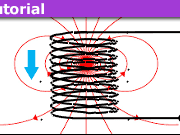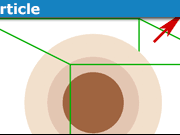What is Impedance? A 5 Minute Introduction
Table of Contents
Definition/Summary
The impedance of a load (a combination of components) in an AC current is a complex number [itex]Z\ =\ R+jX[/itex] where [itex]R[/itex] is the resistance of the load and [itex]X[/itex] is its reactance.
It can also be written in polar form: [itex]Z\ =\ |Z|e^{j\phi}[/itex], or as the phasor [itex]|Z|\angle\phi[/itex].
Impedance is the AC equivalent of resistance: it is used in the AC version of Ohm’s Law: [itex]V_{complex} =\ I_{complex}Z[/itex]
(or [itex](V_{max}/I_{max})\angle\phi =\ Z,\text{ where }\phi[/itex] is the phase difference by which the voltage leads the current), and it obeys the same series or parallel combination laws as resistance does.
Impedance depends on frequency (except for pure resistances).
Impedance is measured in ohms ([itex]\Omega[/itex]).
Equations
For a load across which the voltage leads the current by a phase angle [itex]\phi[/itex]:
[tex]Z\ =\ |Z|cos\phi + j|Z|sin\phi\ =\ R+jX[/tex]
(in polar form: [itex]Z\ =\ |Z|e^{j\phi}[/itex])
(in phasor notation: [itex]Z =\ |Z|\angle\phi[/itex])
Ohm’s Law:
[itex]V_{complex}\ =\ I_{complex}Z[/itex]
[itex](V_{max}/I_{max})\angle\phi =\ Z[/itex]
[itex]V_{max} =\ I_{max}|Z|[/itex]
Series combination:
[itex]Z\ =\ Z_1\ +\ Z_2[/itex]
Parallel combination:
[itex]1/Z\ =\ 1/Z_1\ +\ 1/Z_2[/itex]
Resistor (in any current):
[itex]Z =\ R\ =\ R\angle 0[/itex]
Capacitor in sinusoidal current of frequency [itex]\omega[/itex]:
[itex]Z =\ jX\ =\ 1/j\omega C\ =\ (1/\omega C)\angle -\pi/2[/itex]
Inductor:
[itex]Z =\ jX =\ j\omega L\ =\ \omega L\angle\pi/2[/itex]
Characteristic impedance (ratio of voltage to current) of transmission line at angular frequency [itex]\omega[/itex]:
[tex]Z_0\ =\ \sqrt{\frac{R_x+j\omega L_x}{G_x+j\omega C_x}}
[/tex]
where [itex]R_x\,L_x\,G_x\text{ and }C_x[/itex] are resistance inductance conductance (of the dielectric) and capacitance, all per unit length ([itex]R_x[/itex] is also resistivity per cross-section area, and [itex]G_x[/itex] is also conductivity)
Intrinsic impedance (wave impedance of a plane electromagnetic wave) of a medium:
[tex]Z\ =\ \sqrt{\frac{j\omega\mu}{\sigma+j\omega\varepsilon}}\ =\ \sqrt{\frac{\mu}{\varepsilon-j\sigma/\omega}}[/tex]
for angular frequency [itex]\omega[/itex], where [itex]\mu\ \varepsilon\text{ and }\sigma[/itex] are permeabllity permittivity and conductivity
Intrinsic impedance of vacuum:
[tex]Z_0\ =\ \sqrt{\frac{\mu_0}{\varepsilon_0}}\ =\ \mu_0c\ =\ \frac{1}{\varepsilon_0c}[/tex]
which is defined as exactly [itex]119.9169832\pi\ \Omega[/itex], or approximately [itex]376.73\ \Omega[/itex]
Extended explanation
Introduction:
In resistors, voltage and current are dependent on each other: [itex]V = IR[/itex], but in inductors and capacitors they are independent, and instead one of them is dependent on the rate of change of the other: [itex]dV/dt = I/C\text{ or }V = LdI/dt[/itex].
In a steady AC circuit, however, the rates of change of voltage or current are conveniently proportional to the voltage or current itself (and to the frequency), but 90° out of phase.
So a mathematical trick enables us to replace [itex]V\text{ and }I[/itex] by the constant complex numbers [itex]\boldsymbol{V}\text{ and }\boldsymbol{I}[/itex]. This complex voltage and complex current are dependent on each other: [itex]\boldsymbol{V} = \boldsymbol{I}Z[/itex].
Confusingly, it is standard practice to use the same letters, in the same font, to describe complex voltage (or current) as the actual voltage (or current), and to sometimes even to write the complex voltage and current derivatives as if they were the same as the derivatives of the complex voltage and current (which of course are zero! :rolleyes:).
Please remember that actual current and voltage, and their derivatives, are sinusoidal functions (sharing the same, constant, frequency), but complex current and voltage, and complex current derivative and complex voltage derivative, are all constants.
Complex voltage and current:
In a steady sinusoidal (AC) circuit of frequency [itex]\boldsymbol{\omega}[/itex], the (instantaneous) voltage and current [itex]V\text{ and }I[/itex] can always be written in the form:
[itex]V =\ V_x\cos\omega t + V_y\sin\omega t[/itex] and [itex]I =\ I_x\cos\omega t + I_y\sin\omega t[/itex]
or:
[itex]V =\ \color{blue}{V_{max}}\cos (\omega t+\color{blue}{\phi_V}) =\ \Re(\color{blue}{V_{max}e^{j\phi_V}}e^{j\omega t})[/itex]
[itex]I =\ \color{blue}{I_{max}}\cos (\omega t+\color{blue}{\phi_I}) =\ \Re(\color{blue}{I_{max}e^{j\phi_I}}e^{j\omega t})[/itex]
Then the complex voltage and complex current between any two points are defined as the constants (keeping only the blue parts)
[itex]\boldsymbol{V} =\ V_x+jV_y =\ V_{max}e^{j\phi_V}\text{ and }\ \boldsymbol{I} =\ I_x+jI_y =\ I_{max}e^{j\phi_I}[/itex],
with [itex]j^2=-1[/itex].
The complex number [itex]Z =\ \boldsymbol{V}/\boldsymbol{I}[/itex] is called the impedance between those two points.
Now, [itex]dV/dt \color{grey}{=\ -\omega V_{max}\sin (\omega t+\phi_V)} =\ \Re(\color{blue}{j\omega V_{max}e^{j\phi_V}}e^{j\omega t})[/itex],
and [itex]dI/dt \color{grey}{=\ -\omega I_{max}\sin (\omega t+\phi_I)} =\ \Re(\color{blue}{j\omega I_{max}e^{j\phi_I}}e^{j\omega t})[/itex].
So the complex voltage derivative and complex current derivative between any two points are similarly defined as the constants
[itex]\boldsymbol{V}’ =\ j\omega V_{max}e^{j\phi_V}\ \ \text{and}\ \ \boldsymbol{I}’ =\ j\omega I_{max}e^{j\phi_I}[/itex].
Obviously, [itex]\boldsymbol{V}’ =\ j\omega\boldsymbol{V}\ \ \text{and}\ \ \boldsymbol{I}’ =\ j\omega\boldsymbol{I}[/itex].
Note that the real time-dependent [itex]V\ I\ dV/dt\text{ and }dI/dt[/itex] are the real parts of [itex]e^{j\omega t}[/itex] times the complex constants [itex]\boldsymbol{V}\ \boldsymbol{I}\ \boldsymbol{V}’\text{ and }\boldsymbol{I}’:\ V\ = \Re(e^{j\omega t}\boldsymbol{V}),\ dV/dt\ = \Re(e^{j\omega t}\boldsymbol{V}’)\text{ etc}[/itex].
Resistors capacitors and inductors:
For ordinary voltage and current, Ohm’s Law, and the capacitor and inductor laws, state:
[itex]V =\ RI,\ \ \ dV/dt =\ I/C,\ \ \ V =\ LdI/dt[/itex]
For complex voltage and current, these become:
[itex]\boldsymbol{V} =\ R\boldsymbol{I},\ \ \ \boldsymbol{V}’ =\ \boldsymbol{I}/C,\ \ \ \boldsymbol{V} =\ L\boldsymbol{I}'[/itex]
which can be rewritten without the derivatives as the fundamental complex rules:
[itex]\boldsymbol{V} =\ R\boldsymbol{I},\ \ \ \boldsymbol{V} =\ \boldsymbol{I}/j\omega C,\ \ \ \boldsymbol{V} =\ j\omega L\boldsymbol{I}[/itex]
In other words: the impedances across a resistor capacitor and inductor are:
[itex]Z =\ R,\ \ \ Z =\ 1/j\omega C,\ \ \ Z =\ j\omega L[/itex]
In a varying sinusoidal (AC) circuit of (fixed) frequency [itex]\omega[/itex], the coefficients [itex]V_x\ V’_x\ V_y\ V’_y\ I_x\ I’_x\ I_y\text{ and }I’_y[/itex] are not constants, and the fundamental rules become:
[itex]\boldsymbol{V} =\ R\boldsymbol{I},\ \ \ j\omega C\boldsymbol{V} + Cd\boldsymbol{V}/dt =\ \boldsymbol{I},[/itex][itex]\ \ \ \boldsymbol{V} =\ j\omega L\boldsymbol{I} + Ld\boldsymbol{I}/dt[/itex]
This can be dealt with by replacing the fixed real frequency [itex]\omega[/itex] by a complex “s-plane” (Laplace transform) frequency [itex]s[/itex]
Series law:
For components in series, not separated by any junctions, the current and its derivative are the same.
And total voltage is (by definition) the sum of the component voltages, and so the total impedance is the sum of the individual impedances:
[tex]\boldsymbol{V}_{total} =\ \sum\boldsymbol{V} =\ \left(\sum Z\right)\boldsymbol{I}[/tex]
Parallel law:
For sections of the circuit in parallel (ie, joined to the rest of the circuit and to each other at only two junctions), the voltage and its derivative are the same.
So, from Kirchhoff’s current law, the total current (more correctly, the current entering and leaving at those two junctions) is the sum of the currents through each section, and so the total impedance is the reciprocal of the sum of the reciprocals of the individual impedances:
[tex]\boldsymbol{I}_{total} =\ \sum\boldsymbol{I} =\ \left(\sum 1/Z \right)\boldsymbol{V},\text{ and so }\boldsymbol{V} =\ \left(1\left/\sum 1/Z \right)\right.\boldsymbol{I}_{total}[/tex]
Phasor form:
AC voltage and current are often written in phasor form.
Any complex number, such as [itex]\boldsymbol{V} =\ V_x+jV_y[/itex], can be written as [itex]V_{max}(\cos\phi+j\sin\phi),\text{ where }\tan\phi = V_y/V_x[/itex].
In polar coordinates (or polar form), this is written as the pair [itex](V_{max},\phi)[/itex].
A phasor indicates the same thing: [itex]V_{max}\angle\phi[/itex] (but it is written without brackets, and with an angle instead of a comma). Its main advantage is that it is very easy to write it on a circuit diagram.
Although multiplying or dividing phasors is particularly easy …
[itex]A\angle\phi\times B\angle\psi = AB\angle(\phi+\psi)\ \ [/itex][itex]\ \ \ A\angle\phi / B\angle\psi = (A/B)\angle(\phi-\psi)[/itex]
… adding or subtracting them is particularly difficult. :redface:
Power:
Power = work per time = voltage times charge per time = voltage times current:
[tex]P = VI =\ V_{max}I_{max}\cos(\omega t + \phi/2)\cos(\omega t – \phi/2)[/tex]
[tex]=\ V_{max}I_{max}(\cos\phi + \cos2\omega t)/2[/tex]
(because [itex]2cosAcosB = cos(A-B) + cos(A+B))[/itex])
[tex]=\ V_{rms}I_{rms}(\cos\phi + \cos2\omega t)[/tex]
[tex]=\ \left(V_{rms}^2\left/|Z|\right.\right)(\cos\phi + \cos2\omega t)[/tex]
So (instantaneous) power is the constant part, [itex]P_{av} = V_{rms}I_{rms}\cos\phi[/itex] (the average power), plus a component varying with double the circuit frequency, [itex]V_{rms}I_{rms}\cos2\omega t[/itex] (so a graph of the whole power is a sine wave shifted by a ratio [itex]\cos\phi[/itex] above the x-axis).
Apparent power, reactive power, and complex power, are convenient mathematical definitions with no precise physical significance: apparent power is the (constant) product of the r.m.s. voltage and current, [itex]S=V_{r.m.s.}I_{r.m.s.}[/itex]: it is what we would expect the average power to be if we knew nothing about reactance!
(Average power/apparent power [itex]= P_{av}/S = \cos\phi[/itex] is called the power factor.)
Similarly reactive power is defined as [itex]Q=S\sin\phi=P_{av}\tan\phi[/itex], and complex power is defined as [itex]Se^{j\phi}=P_{av}+jQ[/itex].
This article was authored by several Physics Forums members with PhDs in physics or mathematics.










Leave a Reply
Want to join the discussion?Feel free to contribute!